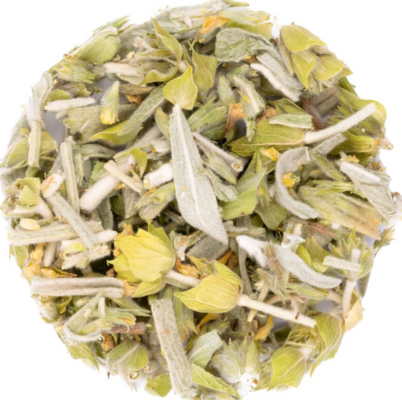Most of us are familiar with the popular South African tisane (herbal tea) Rooibos tea. Fewer of us perhaps with its little brother Honeybush tea, or we might have thought both were different names for the same thing. So what is Honeybush tea and what makes it special?
Honeybush (Cyclopia intermedia) is a flowering plant that shares many similarities with Rooibos (Aspalathus Linearis) in that It exclusively grows in South Africa, contains no caffeine, and has a distinctly red color when brewed. Moreover, the harvesting process for both these tisanes is highly similar; the leaves are cut from the stem of the Honeybush shrub (this allows for regrowth), after which the leaves are oxidized and dried.
However, there are some important differences as well. Honeybush is grown on the Eastern Cape of South Africa while Rooibos grows on the Western Cape. The leaves that a Honeybush shrub produces are thick and short with a deep brown color, while Rooibos leaves have a thinner and longer shape and have a red and orange tint. Also, as the name “Honeybush” is derived from its honey-like aroma and yellow-colored flowers, and as the name suggests, tea made from Honeybush tends to have a sweeter and more earthy taste than Rooibos.

Honeybush tea has been used for its proposed medical benefits for hundreds of years and its use can be traced back to the indigenous San and Khoi people of South Africa. While Honeybush spread to Europe via merchants of The East India Company in the late 17th century, the production of Honeybush tea did not become a sophisticated industry for worldwide consumption until the 1990s.
The health benefits attributed to Honeybush tea are largely due to the high level of antioxidants that the plant contains (it contains even more antioxidants than Rooibos, which has some medical benefits of its own). The particular polyphenols in Honeybush are linked to anti-inflammatory effects and fighting cancer. Furthermore, the tea potentially improves bone and skin health and could boost one’s immune system, help with cholesterol, and alleviate respiratory symptoms. As always, it is important to note that further research is needed to confirm these claims.
Finally, the Honeybush plant contains very low tannin levels, which means that the tea won’t turn bitter after steeping it too long. One of the offshoots of this fact is that in some African homes there is always a pot of Honeybush quietly brewing throughout the day, to offer to potential guests but also to bestow the house with its sweet honey aroma.



